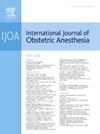Impact of an interdisciplinary process to increase utilization of neuraxial anesthesia for cesarean delivery: A retrospective database analysis
IF 2.6
3区 医学
Q2 ANESTHESIOLOGY
引用次数: 0
Abstract
Background
Neuraxial anesthesia is the preferred anesthesia mode for cesarean delivery (CD). The primary study aim was to study the rate of neuraxial anesthesia for cesarean delivery before and after educational strategies were implemented, focusing on neuraxial anesthesia use for CD.
Methods
We performed a retrospective analysis of the mode of anesthesia for CD. Educational strategies to inform about neuraxial anesthesia for CD included interdisciplinary daily handovers and ward rounds, and interdisciplinary academic meetings and simulation sessions. We retrieved data from the hospital electronic record for mode of anesthesia for CD, intravenous supplementation, to assess the impact of our strategies on neuraxial anesthesia use for CD (2014–2023).
Results
The rate of neuraxial anesthesia increased from 89.8% in 2014 to 96.3% in 2023, with corresponding decrease in general anesthesia from 10.2% to 4.5% for all CD. The use of labor epidural augmentation for unplanned CD increased from 31.9% to 55.1%. Intravenous supplementation with spinal anesthesia for unplanned CD increased from 18.1% to 32.1%.
Conclusions
This study demonstrates the utility of educational strategies to increase neuraxial anesthesia use and highlights the importance of proactive interdisciplinary labor management.
跨学科流程对提高剖宫产神经麻醉利用率的影响:回顾性数据库分析
背景神经轴麻醉是剖宫产(CD)的首选麻醉方式。研究的主要目的是研究教育策略实施前后剖宫产神经麻醉的使用率,重点关注神经麻醉在 CD 中的使用情况。有关 CD 神经阻滞麻醉的教育策略包括跨学科的每日交接班和查房,以及跨学科的学术会议和模拟课程。我们从医院电子病历中检索了CD的麻醉方式、静脉补充麻醉的数据,以评估我们的策略对CD使用神经轴麻醉的影响(2014-2023年)。结果神经轴麻醉率从2014年的89.8%增至2023年的96.3%,所有CD的全身麻醉率相应地从10.2%降至4.5%。计划外分娩时使用硬膜外麻醉的比例从 31.9% 增加到 55.1%。结论这项研究表明,教育策略有助于提高神经麻醉的使用率,并强调了积极主动的跨学科产程管理的重要性。
本文章由计算机程序翻译,如有差异,请以英文原文为准。
求助全文
约1分钟内获得全文
求助全文
来源期刊
CiteScore
4.70
自引率
7.10%
发文量
285
审稿时长
58 days
期刊介绍:
The International Journal of Obstetric Anesthesia is the only journal publishing original articles devoted exclusively to obstetric anesthesia and bringing together all three of its principal components; anesthesia care for operative delivery and the perioperative period, pain relief in labour and care of the critically ill obstetric patient.
• Original research (both clinical and laboratory), short reports and case reports will be considered.
• The journal also publishes invited review articles and debates on topical and controversial subjects in the area of obstetric anesthesia.
• Articles on related topics such as perinatal physiology and pharmacology and all subjects of importance to obstetric anaesthetists/anesthesiologists are also welcome.
The journal is peer-reviewed by international experts. Scholarship is stressed to include the focus on discovery, application of knowledge across fields, and informing the medical community. Through the peer-review process, we hope to attest to the quality of scholarships and guide the Journal to extend and transform knowledge in this important and expanding area.

 求助内容:
求助内容: 应助结果提醒方式:
应助结果提醒方式:


